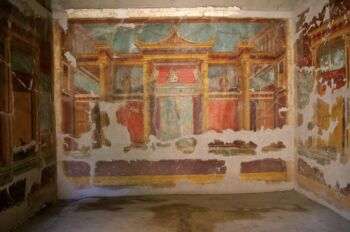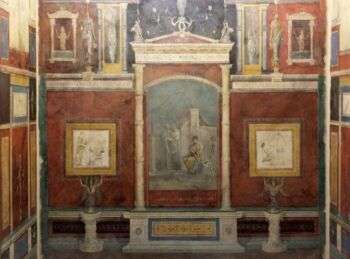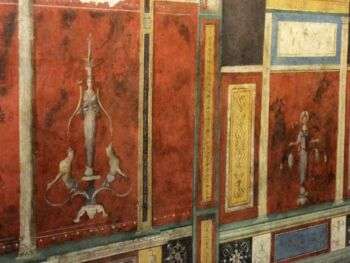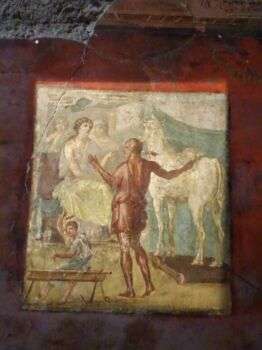The Third Style, also called the Ornate Style, became famous as a reaction to the austerity of the previous styles.

Image source: https://search.creativecommons.org/photos/e7ae8e8b-4c42-4d83-bacc-c5c6f2af8702 by pablocabezos
Landscape and Architectural Decorative Forms
The Third style is a reaction to the austerity of the previous period. It features more figurative and decorations full of colors and details, with an overall ornamental sensibility. Many times, it wants to represent great finesse in executions. The style is often referred to as simplistically elegant.
It dealt with strict rules and symmetry through the main element, that divided the wall into 3 horizontal and 3 to 5 vertical zones. The vertical zones later divided because of the use of geometric motifs or slender columns, light motifs of birds, or semi-fantastical animals depicted in the background. Plants and Egyptian animals often enriched the whole painting.

Image source: https://search.creativecommons.org/photos/b142e667-9a36-4720-b040-6c2fc2a942fa by Amphipolis
These paintings were improved with soft, linear motives, often monochromatic, that took the place of the three-dimensional features of the Second Style. The picture below is an example in the Villa of Livia in Prima Porta near Rome.

Image source: https://search.creativecommons.org/photos/df66849a-35d1-4ef3-9431-3f91cc688fc0 by Amphipolis

Image source: https://search.creativecommons.org/photos/d5217555-8365-447b-b1c9-11d5f586fb31 by Amphipolis
Fantasy and Architecture
The Third Style rather than depicting plausible architectural elements that could be experienced in the everyday world, it was all about fantastic, stylized columns and pediments that could only exist in an alternate reality.
The Roman architect Vitruvius was not an enthusiast about the Third Style painting, and he criticized the paintings for representing monstrosities rather than real things. He said, “for instance, reeds are put in the place of columns, fluted appendages with curly leaves and volutes, instead of pediments, candelabra supporting representations of shrines, and on top of their pediments numerous tender stalks and volutes growing up from the roots and having human figures senselessly seated upon them…” (Vitr.De arch.VII.5.3).
Mythological scenes, landscapes, temples, rolling hills are in the Third Style.
It also introduced Egyptian themes and imagery, including scenes of the Nile as well as Egyptian deities and motifs.

Image source: https://search.creativecommons.org/photos/e7882e1c-c963-4658-9edf-663c5ea5e083

Image source: https://search.creativecommons.org/photos/0782ba45-0f67-4ab8-9de7-7990655b6364
